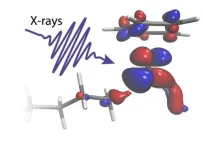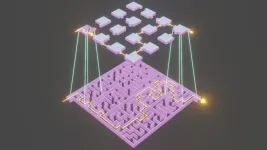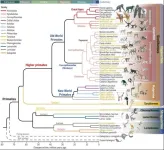(Press-News.org) So far, it has not been possible to explain the causes of around half of all rare hereditary diseases. A Munich research team has developed an algorithm that predicts the effects of genetic mutations on RNA formation six times more precisely than previous models. As a result, the genetic causes of rare hereditary diseases and cancer can be identified more precisely.
Variations of genetic sequence occur relatively frequently – on average, one in a thousand nucleotide of a person’s genome is affected. In rare cases, these changes can lead to defective RNAs and hence non-functional proteins. This can lead to dysfunction in individual organs. If a rare disease is suspected, computer-assisted diagnosis programs can help in the search for possible genetic causes. Specifically the genome can be analyzed using algorithms to find out whether there is a connection between rare genetic variations and dysfunctions in specific parts of the body.
Interdisciplinary research project
Under the leadership of Julien Gagneur, Professor of Computational Molecular Medicine at the Technical University of Munich (TUM) and leader of the Computational Molecular Medicine research group at Helmholtz Munich, an interdisciplinary team from the Informatics and Medicine departments developed a new model that is better than its predecessors at predicting which DNA variations will lead to incorrectly formed RNA.
“A reliable diagnosis can be made for about half of our patients using established DNA analysis methods,” says Dr. Holger Prokisch, co-author of the study and group leader of the Institute of Human Genetics at TUM and Helmholtz Munich. “For the rest, we need models that improve our predictions. Our newly developed algorithm can make an important contribution to this.”
Focus of the model is on splicing
In their study, the researchers considered genetic variations that influence the conversion process of DNA into RNA and ultimately the formation of proteins in a tissue-specific fashion. The focus was on splicing – a process in the cells where the RNA is cut in such a way that the building instructions for the protein can be read later. If there is variation on the DNA, this process can be disrupted and results in either too much or too little being cut from the RNA. Errors in the splicing process are thought to be one of the most common causes of incorrect protein formation and hereditary diseases.
Significantly greater precision than previous studies
The team leverage on existing data sets in order to be able to make statements about possible associations between genetic variations and splicing dysfunctions in specific tissues. These data sets contain DNA and RNA samples from 49 tissues from a total of 946 individuals.
In comparison to previous studies, the team initially considered each sample to see if and to what extent incorrect splicing resulting from variation on the DNA generally manifests itself through splicing dysfunctions in certain tissues. For example, a protein may be relevant for special areas of the heart, while it may have no function in the brain.
“For this purpose, we created a tissue-specific splicing map in which we quantified which places on the RNA are important to splicing in a given tissue. Thanks to our approach, we were able to limit our model to biologically relevant contexts. The skin and blood samples we used enabled us to draw conclusions about hard-to-reach tissues, such as the brain or the heart,” says Nils Wagner, lead author of the study and doctoral student at the Chair of Computational Molecular Medicine at TUM.
In the analysis, each gene with at least one rare genetic variant and that is relevant for protein formation was considered. In addition to the protein-coding sections on the RNA, there are sections that are important for other processes in our cells. These were not considered in the study. This resulted in a total of nearly 9 million rare genetic variants being studied.
“Thanks to our newly developed model, we were able to increase the precision of predicting incorrect splicing sixfold in comparison to previous models. At a recall of 20 percent, previous algorithms achieved a precision of 10 percent. Our model achieves a precision of 60 percent at the same recall,” says Prof. Julien Gagneur.
Precision and recall are important metrics for projecting the effectiveness of models. The precision indicates how many of the genetic variations predicted by the model actually lead to incorrect splicing. The recall shows how many genetic variations mutations that lead to incorrect splicing are recovered by the model.
“We achieved such a large advance in precision by looking at the splicing process in a tissue-specific way and by using direct splicing measurements from easily accessible tissues such as blood or skin cells in order to predict splicing errors in inaccessible tissues like the heart or the brain,” says Prof. Julien Gagneur.
Practical use of the algorithm
The model is being used as part of the European research project “Solve-RD - solving the unsolved rare diseases”. The initiative has set itself the goal of improving the diagnostic outcomes for rare diseases through a broad exchange of knowledge. The team from TUM has already analyzed 20,000 DNA sequences from a total of 6,000 affected families.
Furthermore, the model should make it possible to more easily find the genetic diagnosis of various forms of leukemia in the future. For this purpose, researchers are currently examining 4,200 DNA and RNA samples from leukemia patients.
Further information
Prof. Julien Gagneur came to TUM as an assistant professor in 2016. In 2020, he took over the Chair of Computational Molecular Medicine. His research is on the genetic basis of gene regulation and its effects on diseases using statistical algorithms and machine learning. He is also a research group leader at Helmholtz Munich.
Together with Holger Prokisch, group leader at the Institute of Human Genetics at TUM and Helmholtz Munich, Prof. Julien Gagneur is developing strategies to identify the causes of genetic disorders.
END
Better search for the cause of hereditary diseases
New algorithm six times more reliable at predicting defective RNA
2023-06-01
ELSE PRESS RELEASES FROM THIS DATE:
Cross-cultural analysis reveals evolution and persistence of body-based measurement systems
2023-06-01
Body-based units of measure have cognitive and behavioral advantages over standardized measurement systems, according to a new cross-cultural analysis of the use of body-based measurement in more than 180 cultures worldwide, particularly in the design of ergonomic technologies. The findings reveal new insights into body-based measurement as a cultural phenomenon and may help explain the long-term persistence of their use for centuries after the emergence of standardized measurement systems were invented. The ability to measure things plays a central role in how humans understand and interact with the surrounding world and are important drivers in cultural complexity ...
Autonomous realignment and self-healing in multilayer soft electronic devices
2023-06-01
By combining two dynamic polymers, researchers present a new method for achieving autonomous realignment and self-healing in multilayered soft electronic devices and robots, according to a new study. Like human skin, self-healing polymers allow soft electronic and robotic devices to recover autonomously from various forms of damage. Such devices are often multilayered and embedded with conductive or dielectric materials to achieve functional properties while also maintaining the soft mechanical properties of the self-healing ...
Low-temperature method for 3D printing nanoscale optical-grade glass
2023-06-01
A hybrid organic-inorganic polymer resin enables the three-dimensional (3D) printing of nanoscale optical-grade glass at temperatures roughly half of what other approaches require, researchers report. According to the authors, the approach may help redefine the paradigm for the free-form manufacturing of silica glass and enable its use across a wide variety of new technological applications. Silica glasses possess a unique combination of properties, making them one of the most important materials for ...
Study tracks social, genetic evolution in Asian colobine primates
2023-06-01
CHAMPAIGN, Ill. — Asian colobines, also known as leaf-eating monkeys, have been on the planet for about 10 million years. Their ancestors crossed land bridges, dispersed across continents, survived the expansion and contraction of ice sheets and learned to live in tropical, temperate and colder climes.
A new study reported in the journal Science finds parallels between Asian colobines’ social, environmental and genetic evolution, revealing for the first time that colobines living in colder regions experienced genetic changes and alterations to their ancient social structure that likely enhanced their ability ...
X-rays visualize how one of nature’s strongest bonds breaks
2023-06-01
Embargoed until 1-Jun-2023 14:00 ET (1-Jun-2023 18:00 GMT/UTC)
The use of short flashes of X-ray light brings scientists one big step closer toward developing better catalysts to transform the greenhouse gas methane into a less harmful chemical. The result, published in the journal Science, reveals for the first time how carbon-hydrogen bonds of alkanes break and how the catalyst works in this reaction.
Methane, one of the most potent greenhouse gases, is being released into the atmosphere at an increasing rate by livestock farming as well as the continuing unfreezing of permafrost. Transforming methane and longer-chain alkanes into less harmful and in fact useful chemicals ...
New study shows how adaptations to living in a cold climate promoted social evolution
2023-06-01
For the first time ever, scientists have uncovered evidence that a species’ long-term adaptation to living in an extremely cold climate has led to the evolution of social behaviours including extended care by mothers, increased infant survival and the ability to live in large complex multilevel societies.
The new study, published today in the journal Science, was led by researchers from Northwest University in China and a team including the University of Bristol (UK) and the University of Western Australia, ...
People divide complex tasks into simpler subtasks in a way that balances ease of planning with efficient behavior, consistent with a new computational theory
2023-06-01
Article URL: https://journals.plos.org/ploscompbiol/article?id=10.1371/journal.pcbi.1011087
Article Title: Humans decompose tasks by trading off utility and computational cost
Author Countries: USA
Funding: This research was supported by John Templeton Foundation grant 61454 awarded to TLG and NDD (https://www.templeton.org/), U.S. Air Force Office of Scientific Research grant FA 9550-18-1-0077 awarded to TLG (https://www.afrl.af.mil/AFOSR/), and U.S. Army Research Office grant ARO W911NF-16-1-0474 awarded to NDD (https://www.arl.army.mil/who-we-are/directorates/aro/). ...
LSU researchers show mobile elements monkeying around the genome
2023-06-01
Baboons (Papio) are found across the continent of Africa, from the west to the east and all the way south. They have doglike noses, impressive teeth and thick fur that ranges widely in color between the six species, which are olive, yellow, chacma, Kinda, Guinea and hamadryas. Their habitats vary from savannas and bushlands to tropical forests and mountains. Chacma baboons, the largest at up to 100 pounds, are even found in the Kalahari Desert, while the neighboring Kinda baboons, the smallest at around 30 pounds, stay near water. Most live in large troops with dozens or hundreds of members. While most baboons ...
The Primate Genome Project unlocks hidden secrets of primate evolution
2023-06-01
Co-led by Guojie Zhang from Centre for Evolutionary & Organismal Biology at Zhejiang University, Dong-Dong Wu at Kunming Institute of Zoology, Xiao-Guang Qi at Northwest University, Li Yu at Yunnan University, Mikkel Heide Schierup at Aarhus University, and Yang Zhou at BGI-Research, the Primate Genome Consortium reported a series of publications from its first phase program which includes high quality reference genomes from 50 primate species of which 27 were sequenced for the first time. These studies provide new insights on the speciation process, genomic diversity, social evolution, ...
Major primate genome sequencing studies reveal new insight into evolution, biodiversity and key applications for human health
2023-06-01
HOUSTON – (June 1, 2023) – A new investigation led by researchers at Baylor College of Medicine’s Human Genome Sequencing Center, the Institute of Evolutionary Biology and Pompeu Fabra University in Barcelona, Spain, and Illumina, Inc. analyzed the genomes of 233 nonhuman primate species and revealed key features of primate evolution, human disease and biodiversity conservation. The findings are published in a series of studies in a special issue of the journal Science.
The Primate Genome Project generated the most complete ...
LAST 30 PRESS RELEASES:
Implant provides lasting relief for treatment-resistant depression
Autologous T cell therapy targeting multiple antigens shows promise treating pancreatic cancer
First extensive study into marsupial gut microbiomes reveals new microbial species and antimicrobial resistance
Study debunks myth of native Hawaiians causing bird extinctions
Tailored biochar could transform how crops grow, resist disease, and clean polluted soils
Biochar-based enzyme technology offers new path for cleaner water and soil
Biochar helps farmland soils withstand extreme rain and drought by steadying carbon loss
New study reveals major gaps in global forest maps
Ochsner Health names Dr. Timothy Riddell executive vice president and chief operating officer
Can future-focused thoughts help smokers quit?
From brain scans to alloys: Teaching AI to make sense of complex research data
Stem Cell Reports seeks early career editors to join the editorial board
Signs of ancient life turn up in an unexpected place
Pennington Biomedical researchers explore factors behind body’s ability to regulate weight
Zhongping Lee awarded the Nils Gunnar Jerlov Medal
Deborah S. Kelley awarded the Wallace S. Broecker Medal
Novel immunotherapy demonstrates early potential to overcome resistance to immune checkpoint therapy
LLM treatment advice agrees with physician recommendations in early-stage HCC, but falls short in late stage
Deep learning model trained with stage II colorectal cancer whole slide images identifies features associated with risk of recurrence – with higher success rate than clinical prognostic parameters
Aboard the International Space Station, viruses and bacteria show atypical interplay
Therapies that target specific type of cell death may be an effective avenue for cancer treatment, UTHealth Houston researchers find
CHEST releases guideline on biologic management in severe asthma
Scientists create a system for tracking underwater blackouts
Fruit fly pigmentation guides discovery of genes that control brain dopamine and sleep
World's largest physics conference to be held in Denver and online this March
New mega-analysis reveals why memory declines with age
Understanding ammonia energy’s tradeoffs around the world
UTHealth Houston researchers map gene disruptions in sporadic early onset Alzheimer’s disease across key brain regions
Minimum wage increases are linked to safer pregnancies
Left in the cold: Study finds most renters shut out of energy-saving upgrades
[Press-News.org] Better search for the cause of hereditary diseasesNew algorithm six times more reliable at predicting defective RNA




